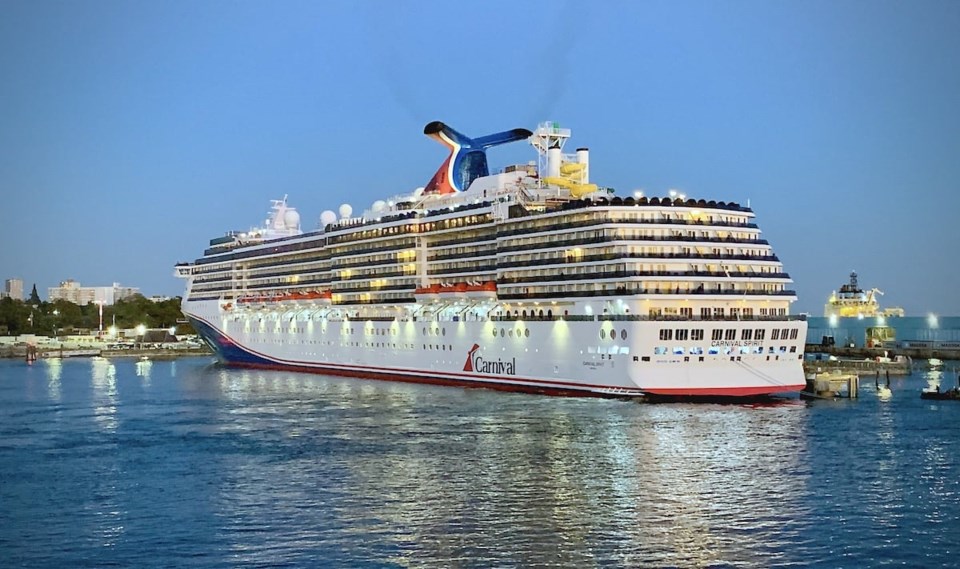Some new cruise-ship pollution measures are now mandatory, but environmental groups say the move still doesn’t plug gaps that permit the ongoing contamination of some of Canada’s most sensitive coastlines.
Minister of Transport Omar Alghabra announced recently that voluntary measures established last April on the discharge and treatment guidelines for sewage (black water) and grey water — which includes kitchen water, laundry detergent, cleaning products, food waste, cooking oils and grease as well as carcinogens and other pollutants — will be mandatory immediately under an interim order.
But the largest source of acidic waste water from cruise ships and other vessels will continue to flow into the ocean unabated, said Anna Barford, shipping campaigner for Stand.earth Canada.
More than 90 per cent of cruise ships’ polluted discharge comes from onboard scrubber systems — exhaust-cleaning systems that use water to “wash” pollutants such as sulphur dioxide, carcinogens and heavy metals from exhaust and then flush them into the ocean rather than the air.
That discharge isn’t covered by the rules. Nor are there dedicated onboard observers to ensure cruise ships follow the new sewage and grey water rules, Barford said.
“We know from the experience of our [U.S.] neighbours it’s necessary to enforce and catch the rule breakers,” she said.
The new regulations prohibit cruise ships from dumping grey water or sewage within three nautical miles of shore. And they call for better treatment for grey water discharge, requiring cruise ships to use a marine sanitation device in order to dump grey water within 12 nautical miles of shore.
Vessels must report they are complying with the measures on request, and if found to be breaking the rules during inspection, which takes place at port, they face a potential maximum penalty of $250,000, said Transport Canada.
The new sewage and grey water regulations are in line with the more stringent rules already in place in Canada’s Arctic and other comparable waters along the West Coast, such as in Alaska, California and Washington state, Transport Canada added.
But Barford said the ministry was silent about the fact it’s OK for cruise vessels to dump scrubber wastewater along the length of B.C.’s inland coast, as well as in federal marine protected areas and the Arctic Ocean, a particularly sensitive marine ecosystem facing dramatic increases in shipping as the sea ice melts with climate change.
The ministry did not clarify if or when it plans to take action to ban or restrict polluted scrubber wash water — something numerous jurisdictions, including California and European countries such as Germany and France, have already done, she added.
Polluted scrubber water could be avoided if ships were required to use cleaner-burning fuels to meet the International Maritime Organization’s emission standards.
But the IMO and Canada’s rules allow ships to use dirty heavy fuel oil if they also use scrubber systems.
Barford said both Transport Canada and the IMO should prohibit scrubbers that enable vessels to continue using cheaper, more polluting fossil fuels at a time when shipping’s emissions footprint is growing and there is an urgent need to shift to low- or zero-emission fuels.
“They’ve taken an air-pollution problem and turned it into a water-pollution problem,” said Barford, adding the scrubber systems don’t deal with black carbon, or soot, which speeds up melting when it lands on snow in the Arctic.
Scrubber discharge worsens ocean acidification, which limits the ability of marine creatures such as oysters, clams, prawns and crabs to form shells, especially in the early stages of their life. And heavy metals and toxins from the wastewater can build up in the food chain, threatening the health and reproduction of marine animals, especially larger ones such as endangered resident killer whales.
Although cargo vessels and other boats use heavy fuel oil and scrubber systems, cruise ships create exponentially more pollution because of where and how they travel, Barford noted.
“Cruise ships linger in these sensitive inshore areas along the coast and have a very high energy demand,” she said. “So they go through a lot more fuel and create much more discharge than a ship that isn’t operating a hotel onboard.”
The IMO met recently to try to devise new shipping emission standards in an effort to limit global warming, Barford noted.
It’s not clear banning scrubbers to eliminate heavy fuel oil use was on the IMO negotiating table — but if it wasn’t, it should be, she added, noting it would force the cruise and shipping sectors to transition to cleaner or alternative fuels.
“Look at jurisdictions that have banned scrubbers like California,” she said. “They’re acquiring more refined fuels, they’re preparing for renewables and zero-emissions fuels by eliminating [heavy fuel oil], the worst one available.”
Transport Canada did not provide answers to Canada’s National Observer’s questions about potential federal scrubber discharge regulations before publishing deadline.



